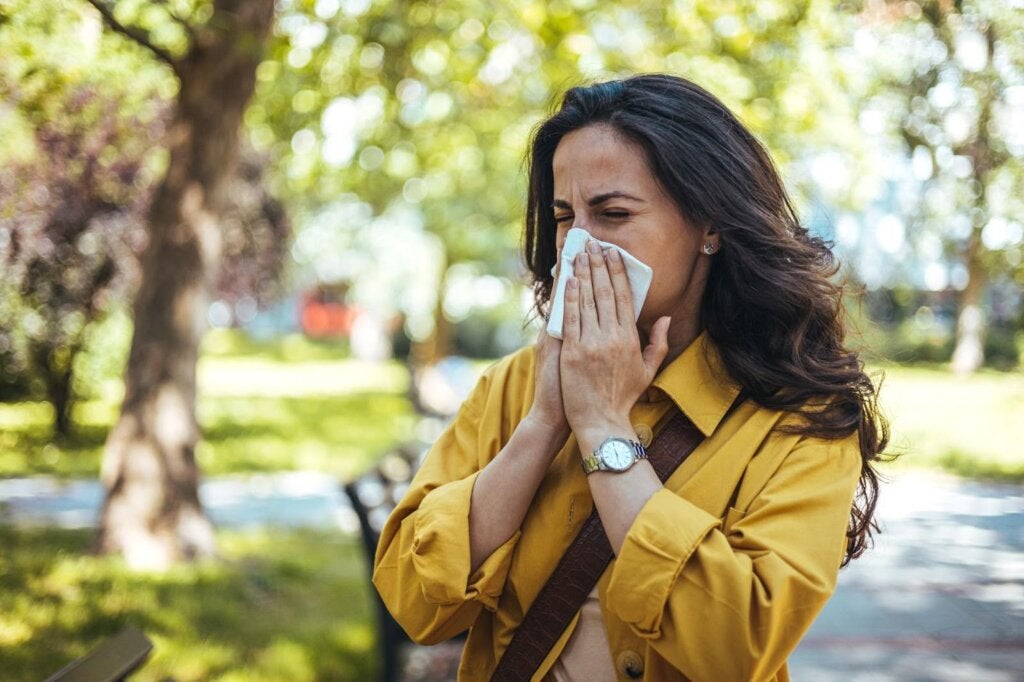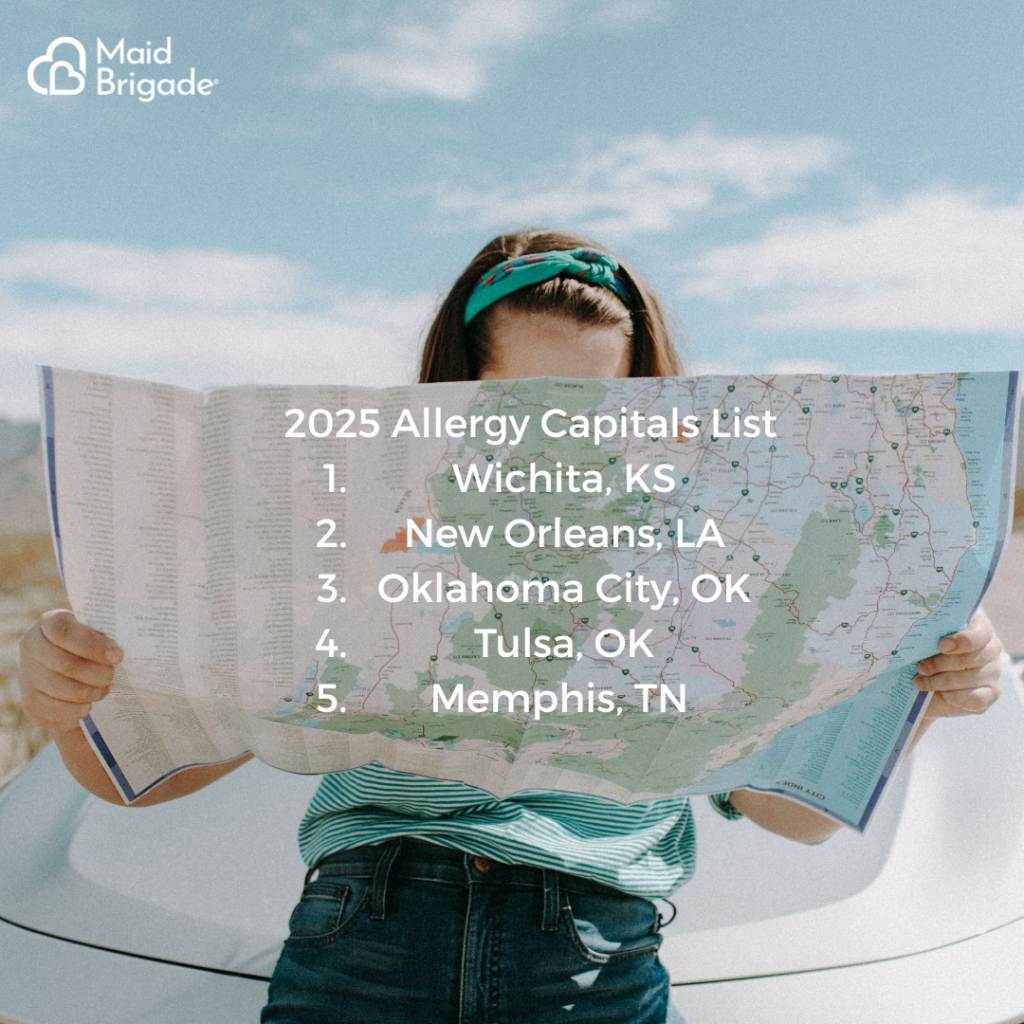
Sneezing Indoors? It’s Not Just Pollen Outside
If you’ve been sniffling, sneezing, or waking up congested – even after peak pollen season – you’re not imagining things. The 2025 Allergy Capitals Report from the Asthma and Allergy Foundation of America (AAFA) has officially named the worst U.S. cities for allergy sufferers. Take a peek! Your city might be on the list or not far behind.
Even if you escape the top 10, you’re not necessarily in the clear. Indoor allergens are a growing concern, and they don’t care about your ZIP code. Dust mites, mold spores, pollen tracked indoors, and even pet dander can make allergy season feel year-round. And if you or your loved ones already struggle with asthma or seasonal allergies, your home can either help (or hurt) your health.
Which Cities Made the 2025 Allergy Capitals List?
According to the AAFA’s 2025 rankings, the top five worst cities for allergy sufferers are:
- Wichita, KS
- New Orleans, LA
- Oklahoma City, OK
- Tulsa, OK
- Memphis, TN

These rankings are based on several factors, including pollen counts, allergy medication use, and availability of board-certified allergists. But even cities not on the list are dealing with rising pollen levels, prolonged allergy seasons, and indoor air quality issues.
Translation? If you’ve got itchy eyes or a scratchy throat, your home environment could be playing a bigger role than you think.
Should You Move if You Live in an Allergy Capital?
The Asthma and Allergy Foundation of America (AAFA) tackles this question directly in its 2025 Allergy Capitals Report: should people consider moving away from high-ranking allergy cities? Their answer is clear: probably not. While cities may differ in pollen counts, allergy triggers are everywhere. No matter where you live, you can experience seasonal allergies, because pollen and environmental allergens are widespread and often unavoidable.
This reinforces an important truth: your home environment plays a much bigger role in your daily allergy experience than the city you live in. Moving won’t guarantee relief, but making your home a safe haven can. That’s where the proactive cleaning strategies we’ll discuss in this blog matter most. When you keep dust, pollen, and other allergens out of your indoor spaces, you can drastically reduce symptoms and enjoy greater comfort without uprooting your life.
How Allergens Invade Your Home (and Stay There)
You can’t always control the air outside, but inside your home, you have options. Here’s where allergens like to hide:
- Soft Surfaces
Carpets, rugs, curtains, and upholstery trap dust, pollen, and pet dander. - HVAC Systems & Air Filters
Dirty filters recirculate allergens and mold spores through your home. - Floors & Baseboards
Pollen and dust settle in the corners and cracks you often miss during light cleaning. - Bathrooms & Kitchens
Mold thrives in damp, humid spaces, especially around tile grout and vents. - Bedding & Mattresses
Dust mites love pillows and mattresses. Without regular deep cleaning, your bed can become an allergy minefield.
Even with regular tidying, most households don’t remove allergens at the microscopic level. That’s when symptoms stick around or get worse.
Signs Your Home Might Be Making Allergies Worse
Allergy symptoms that seem to “stick” after you’re home for a while are a red flag. Watch for:
- Congestion that improves when you leave the house
- Coughing or sneezing after making the bed or vacuuming
- Itchy eyes or throat in rooms with carpet or heavy drapes
- Worsening asthma symptoms indoors
- Constant need for allergy meds, even on low-pollen days
If these sound familiar, a deep allergen-focused cleaning may help more than you think.
5 Ways to Reduce Indoor Allergens Starting Today
Here’s what experts recommend:
- Upgrade to a HEPA Filter Vacuum
These trap particles that standard vacuums often recirculate. - Wash Bedding Weekly in Hot Water
Hot water kills dust mites and removes allergen buildup. - Use a Dehumidifier in Damp Spaces
Mold spores thrive in humidity above 50%. - Wipe Down Hard Surfaces Often
Pollen settles quickly on counters, window sills, and floors. - Schedule a Professional Allergen Cleaning
Services like Maid Brigade’s PUREcleaning® system use electrolyzed water and deep-surface disinfection to safely eliminate allergens without harsh chemicals.
PUREcleaning®: Safe, Science-Backed Relief for Allergy Sufferers
Maid Brigade’s PUREcleaning® process goes deeper than your average surface clean. In fact, it’s a wellness upgrade for your entire home. Here’s why it works:
- Non-toxic and residue-free: No harsh chemicals, no lingering fumes
- Disinfection power: Kills bacteria, mold, and viruses on hard and soft surfaces
- Thorough clean: Penetrates fibers and crevices where allergens hide
- Pet and kid safe: Safe for families, effective for allergy relief
When you’re battling environmental triggers and local allergies, a clean home is a necessity. PUREcleaning® gives you a clean you can truly feel.
FAQ: Allergy Season, Home Cleaning, and You
Q: I don’t live in one of the worst cities for allergies. Should I still worry about allergens at home?
A: Yes. Local allergies reflect outdoor conditions, but indoor allergen buildup can happen anywhere, especially if you have carpeting or pets, or live in a humid climate.
Q: Does Maid Brigade clean air ducts or HVAC systems?
A: We don’t currently provide ductwork services, but we do clean the surrounding surfaces where dust, mold, and pollen collect. We can also recommend HVAC professionals if needed.
Q: How often should I schedule allergen-focused cleaning?
A: Seasonal deep cleans (every 3-4 months) are ideal, especially during spring and fall when local allergens peak.
Breathe Easier Where It Matters Most
Allergy season may be out of your control. But what happens inside your home? That’s where Maid Brigade shines.
Whether your city is allergy-prone or not, our expert team is ready to help you breathe easier, sleep better, and feel healthier, all starting with a cleaner home.Book your PUREcleaning® appointment today!


